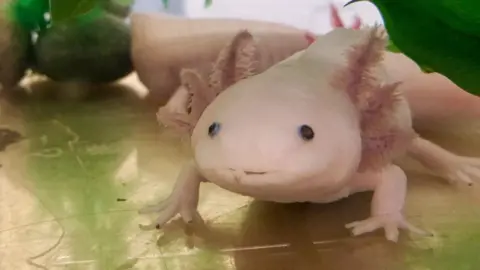The axolotl, an extraordinary amphibian native to Mexico, has become a beacon of hope amidst the perilous threat of extinction. A recent scientific study highlights a significant milestone in a conservation effort aimed at reviving the dwindling population of this peculiar creature. Known for its distinctive smile and regenerative capabilities, the axolotl has a storied legacy that stretches back to Aztec mythology, where it holds a place of reverence as the god of fire and lightning, Xolotl.
In a momentous initiative, researchers led by Dr. Alejandra Ramos from the Autonomous University of Baja California released 18 captive-bred axolotls into restored wetlands near Mexico City. The release took place in artificial wetland habitats that researchers carefully reestablished in collaboration with local farmers and volunteers. This strategic move exemplifies the potential for amphibians like the axolotl to flourish once again in their natural environments.
The results of this experiment have been nothing short of remarkable. Equipped with radio trackers, the released axolotls demonstrated resilient survival skills, thriving in their new habitats and even gaining weight, an encouraging sign that they are foraging successfully and adapting to their surroundings. Dr. Ramos expressed her excitement at these findings, noting that not only did the axolotls survive, but they also displayed positive behavioral traits, including forming social bonds with one another.
Published in the journal PLoS One, the study underscores the viability of reintroducing the axolotl to its native habitat, particularly in the Xochimilco region. This area, once teeming with axolotls, has seen their numbers plummet due to urbanization, pollution, and habitat destruction, with estimates suggesting as few as 50 remain in the wild today. Co-lead researcher Dr. Luis Zambrano from the National University of Mexico emphasized the cultural significance of the axolotl, insisting that losing this species would equate to erasing a part of Mexico’s identity.
Historically, the wetlands of Xochimilco, known for their intricate systems of canals cultivated through traditional farming practices, have been the axolotl’s home. However, as Mexico City expanded, the natural balance was disrupted, leading to pollution and habitat loss that put the axolotl on the brink of extinction. This current restoration project, therefore, not only aims to improve the habitat but also serves as a critical reminder of the interconnectivity between the environment and human wellbeing.
The project reflects a broader theme of hope for conservationists as they strive to restore the wetlands and combat environmental degradation in a city of over 20 million inhabitants. Dr. Zambrano articulated a powerful vision for the future: if the axolotl can be revived within this urban landscape, it symbolizes humanity’s ability to restore nature and foster a sustainable coexistence.
To support the axolotl’s revival, researchers undertook extensive groundwork, setting up wetland refuges equipped with natural filtration systems for improving water quality. Notably, the released axolotls were tracked to gather insights into their behavior and habits. One intriguing discovery was that some axolotls tended to form social pairs, showcasing unique interactions akin to friendships.
Despite their popularity as pets and laboratory specimens, predominantly bred for scientific research given their ability to regenerate limbs, the axolotl’s future in the wild remains precarious. Pride in restoring the axolotl population entails a sustained commitment to cleaning up their habitats and educating the public about the imperative of conservation efforts.
Dr. Ramos encourages all citizens to play an active role in these efforts, advocating for grassroots involvement in habitat restoration. “You don’t need to be a scientist to get involved; everybody in the world can help out,” she asserted, emphasizing that each contribution, small or large, can make a difference in protecting not just the axolotl, but global biodiversity as a whole.
Thus, the encouraging outcomes of the axolotl release shed light on a promising path toward rebuilding populations of endangered species while inspiring hope that collective action can lead to substantial environmental change.



